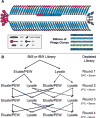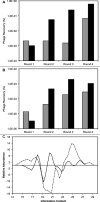Selection of Lung Cancer-Specific Landscape Phage for Targeted Drug Delivery
- PMID: 27095536
- PMCID: PMC5066567
- DOI: 10.2174/1386207319666160420141024
Selection of Lung Cancer-Specific Landscape Phage for Targeted Drug Delivery
Abstract
Cancer cell-specific diagnostic or therapeutic tools are commonly believed to significantly increase the success rate of cancer diagnosis and targeted therapies. To extend the repertoire of available cancer cell-specific phage fusion proteins and study their efficacy as navigating moieties, we used two landscape phage display libraries f8/8 and f8/9 displaying an 8- or 9-mer random peptide fusion to identify a panel of novel peptide families that are specific to Calu-3 cells. Using a phage capture assay, we showed that two of the selected phage clones, ANGRPSMT and VNGRAEAP (phage and their recombinant proteins are named by the sequence of the fusion peptide), are selective for the Calu-3 cell line in comparison to phenotypically normal lung epithelial cells and distribute into unique subcellular fractions.
Conflict of interest statement
Statement The authors declare that the research was conducted in the absence of any commercial or financial relationships that could be construed as a potential conflict of interest.
Figures



Similar articles
-
Metastatic prostate cancer cell-specific phage-like particles as a targeted gene-delivery system.J Nanobiotechnology. 2013 Sep 23;11:31. doi: 10.1186/1477-3155-11-31. J Nanobiotechnology. 2013. PMID: 24059645 Free PMC article.
-
Landscape phages and their fusion proteins targeted to breast cancer cells.Protein Eng Des Sel. 2012 Jun;25(6):271-83. doi: 10.1093/protein/gzs013. Epub 2012 Apr 6. Protein Eng Des Sel. 2012. PMID: 22490956 Free PMC article.
-
Promiscuous tumor targeting phage proteins.Protein Eng Des Sel. 2016 Mar;29(3):93-103. doi: 10.1093/protein/gzv064. Epub 2016 Jan 12. Protein Eng Des Sel. 2016. PMID: 26764410 Free PMC article.
-
Phage Display Libraries: From Binders to Targeted Drug Delivery and Human Therapeutics.Mol Biotechnol. 2019 Apr;61(4):286-303. doi: 10.1007/s12033-019-00156-8. Mol Biotechnol. 2019. PMID: 30729435 Review.
-
Phage protein-targeted cancer nanomedicines.FEBS Lett. 2014 Jan 21;588(2):341-9. doi: 10.1016/j.febslet.2013.11.011. Epub 2013 Nov 20. FEBS Lett. 2014. PMID: 24269681 Free PMC article. Review.
Cited by
-
Protein Engineering: Advances in Phage Display for Basic Science and Medical Research.Biochemistry (Mosc). 2022 Jan;87(Suppl 1):S146-S110. doi: 10.1134/S0006297922140127. Biochemistry (Mosc). 2022. PMID: 35501993 Free PMC article. Review.
-
Phage-Displayed Mimotopes of SARS-CoV-2 Spike Protein Targeted to Authentic and Alternative Cellular Receptors.Viruses. 2022 Feb 14;14(2):384. doi: 10.3390/v14020384. Viruses. 2022. PMID: 35215976 Free PMC article.
-
Landscape Phage: Evolution from Phage Display to Nanobiotechnology.Viruses. 2018 Jun 7;10(6):311. doi: 10.3390/v10060311. Viruses. 2018. PMID: 29880747 Free PMC article. Review.
-
Combinatorial Avidity Selection of Mosaic Landscape Phages Targeted at Breast Cancer Cells-An Alternative Mechanism of Directed Molecular Evolution.Viruses. 2019 Aug 26;11(9):785. doi: 10.3390/v11090785. Viruses. 2019. PMID: 31454976 Free PMC article.
-
The power of phages: revolutionizing cancer treatment.Front Oncol. 2023 Nov 15;13:1290296. doi: 10.3389/fonc.2023.1290296. eCollection 2023. Front Oncol. 2023. PMID: 38033486 Free PMC article. Review.
References
-
- Siegel R, Ma J, Zou Z, Jemal A. Cancer Statistics, 2014. CA Cancer J Clin. 2014;64:9–29. - PubMed
-
- Vescio RA, Connors KM, Bordin GM, Robb JA, Youngkin T, Umbreit JN, Hoffman RM. The Distinction of Small Cell and Non-Small Cell Lung Cancer by Growth in Native-State Histoculture. Cancer Res. 1990;50:6095–6099. - PubMed
-
- Fraire AE, Roggli VL, Vollmer RT, Greenberg SD, McGavran MH, Spjut HJ, Yesner R. Lung Cancer Heterogeneity. Prognostic Implications. Cancer. 1987;60:370–375. - PubMed
-
- Modok S, Mellor HR, Callaghan R. Modulation of Multidrug Resistance Efflux Pump Activity to Overcome Chemoresistance in Cancer. Curr Opin Pharmacol. 2006;6:350–354. - PubMed
Publication types
MeSH terms
Substances
Grants and funding
LinkOut - more resources
Full Text Sources
Other Literature Sources
Medical
Miscellaneous

